English traning material
- 格式:ppt
- 大小:718.50 KB
- 文档页数:12
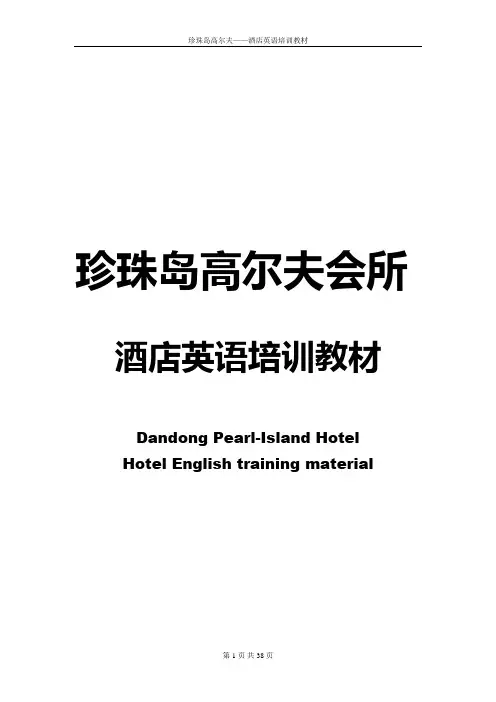
珍珠岛高尔夫会所酒店英语培训教材Dandong Pearl-Island HotelHotel English training material目录第一章酒店根底英语 (1)第二章酒店前台英语 (7)第三章酒店礼宾英语 (17)第四章酒店商务中心英语 (23)第五章酒店总机英语 (26)第六章酒店客房英语 (28)第七章酒店餐饮英语 (34)第八章酒店收银英语 (42)第一章酒店根底英语●礼貌用语 Courtesy EnglishGood morning/afternoon/evening, Sir/Madam. 早上好/下午好/晚上好。
Nice to meet you. 很快乐见到你。
Welcome to our hotel. 欢送光临我们酒店。
Have a good time. 祝您在酒店过的愉快。
●用语 Telephone sentencesWait a moment, please. 对不起,请稍等。
Sorry, he is no in at the moment. 对不起,他暂时不在。
I beg your pardon? 对不起〔我没听清楚〕。
Could you speak a little slower, please?请您稍微讲慢一点。
●答谢用语 Thanks and answerThank you. 谢谢。
It’s very kind of you. 谢谢,您真客气。
You are welcome. 不用谢。
It is my pleasure. 非常乐意为您效劳。
I am at your service. 随时为您效劳。
That is all right. 没关系。
●征询语 ConsultCan I help you? / How many I help you? 我能为您做些什么?What is your suggestion? 您有什么意见或建议吗?Excuse me; may I have your name? 对不起,请问您怎么称呼?●指路 Asking and giving directionsThis way, please. 这边请。
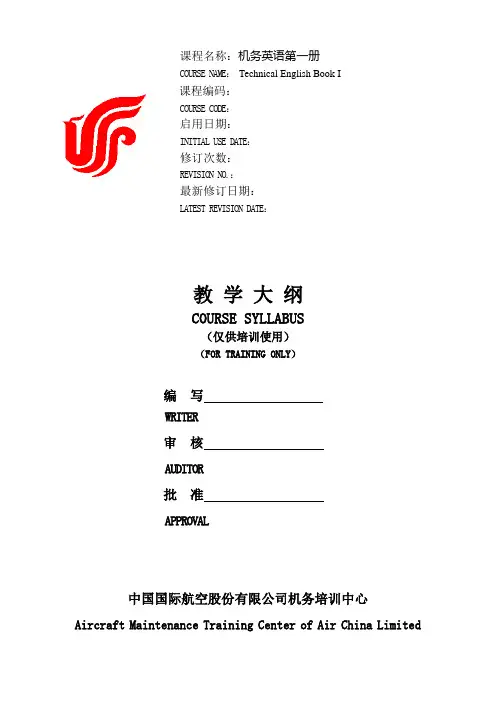
课程名称:机务英语第一册COUR SE NAM E:Technical English Book I课程编码:COUR SE COD E:启用日期:INIT IAL US E D ATE:修订次数:REVI SIO N N O.:最新修订日期:LATE ST REV ISI ON DAT E:教学大纲COURSE SYLLABUS(仅供培训使用)(FOR TRAINING ONLY)编写WRITER审核AUDITOR批准APPROVAL中国国际航空股份有限公司机务培训中心Aircraft Maintenance Training Center of Air China Limited课程名称:机务英语第一册Course Name: Technical English Book I课程编码: Course Code:课程长度: 学时204Course Duration: 204 hours培训对象:Target Group:人员资格:Qualifications Required:●教员资格:经过分公司人力部组织的机务英语教员培训的人员Instructor Qualification Required: Instructor authorized by aircraft maintenance training center of Air China●学员资格:有初中英语水平或完成了起点英语课程的人员Trainees Qualification Required: personnel who possesses middle school English level or successfully finished the beginners English training.培训目标: 通过培训,使受培人员能够:Objectives: After completing this course, trainees are able to:●完成培训后,能够拥有基本的技术词汇,阅读简单的英文工卡Mastering the fundamental technical vocabulary , being able to read related English version job cards课程内容:教 学大 纲 COURSE SYLLABUS国航股份AIR CHINA LIMITEDContents:a vocabulary of about 1000 technical words, simple sentence patterns in describing objects and machine working principles.课程实施:Course Conduction:●培训班规模:最多20Class Scale: max. 20 trainees●资料(教材):《机务英语第一册》Training Material:Technical English Book I●培训设施、用具:多媒体投影仪Teaching Equipment and Tool: Multimedia projector课程规范:符合CCAR145的要求Course Specification:Comply with the CCAR145培训方式:课堂教学Training Method:Training conducted in classroom考试:参加工程技术分公司统一考试,60%分及格Exam: , passed mark is 70%机务英语第一册课时分配Technical English Book I机务英语第一册教学提纲Technical English Book I Course Syllabus(一)词汇量:大约1200。

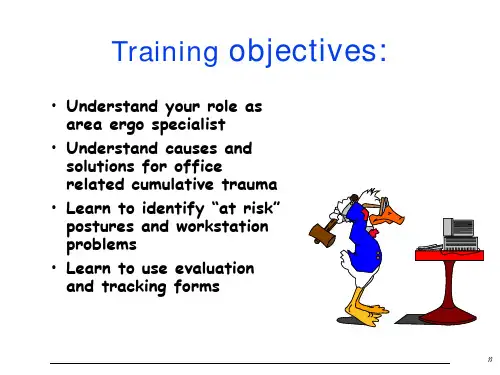

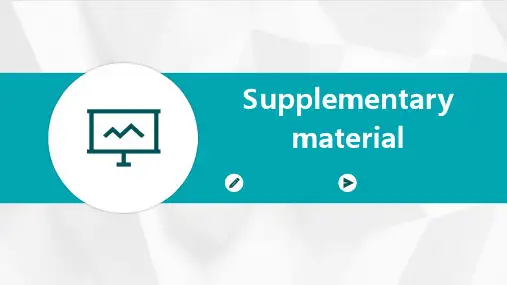
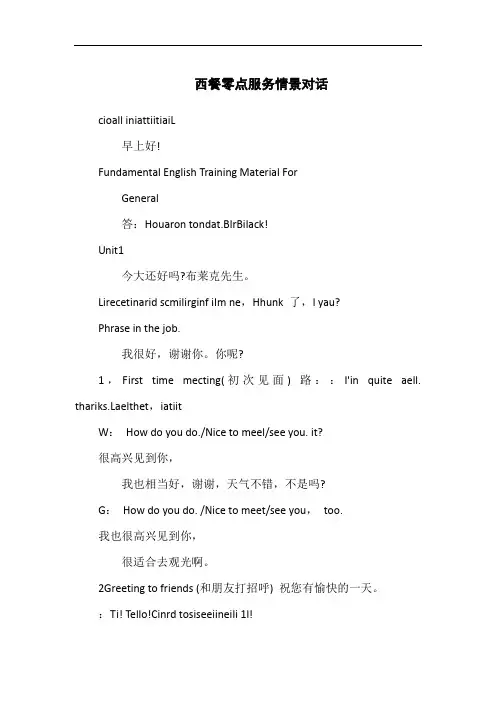
西餐零点服务情景对话cioall iniattiitiaiL早上好!Fundamental English Training Material ForGeneral答:Houaron tondat.BlrBilack!Unit1今大还好吗?布莱克先生。
Lirecetinarid scmilirginf iIm ne,Hhunk 了,l yau?Phrase in the job.我很好,谢谢你。
你呢?1,First time mecting(初次见面) 路::I'in quite aell. elthet,iatiitW:How do you do./Nice to meel/see you. it?很高兴见到你,我也相当好,谢谢,天气不错,不是吗?G:How do you do. /Nice to meet/see you,too.我也很高兴见到你,很适合去观光啊。
2Greeting to friends (和朋友打招呼) 祝您有愉快的一天。
:Ti! Tello!Cinrd tosiseeiineili 1l!你好!/好啊!/很高兴见到你! :Br行,Pleai let ine irtivauluce alr G:Hi!/Hello! / Good to see/meel you too! /Me Zhang to you. And Mr Zhang,This is Mrtoo.Brown,CEO(ChiefExecutive你好!!好啊!/我也很高兴见到你!/我officer joticrosoaTatinn.也是。
布朗先生,请让我介绍下张先生给你,还有这是布朗先生,微软的首席执行官。
Greeting(问候)iie is imeil yl,Mt Prt门W:llirnirom Ticnins很高兴见到你,布朗先生,B:Good to see you,too,Mr Zhang.早上/下午/晚上好!XXXX(知道名字)。
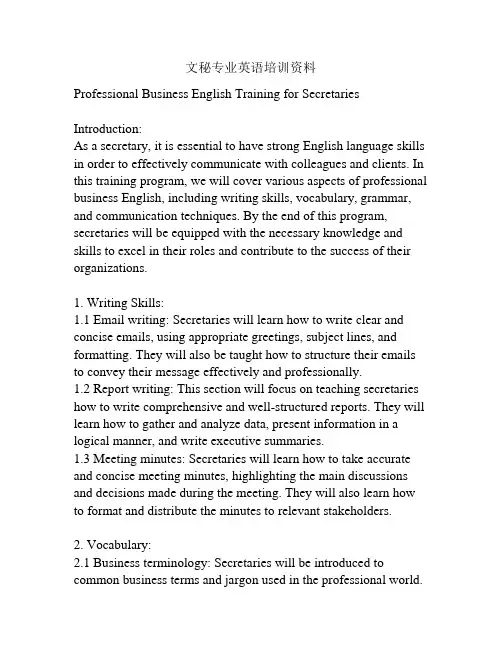
文秘专业英语培训资料Professional Business English Training for Secretaries Introduction:As a secretary, it is essential to have strong English language skills in order to effectively communicate with colleagues and clients. In this training program, we will cover various aspects of professional business English, including writing skills, vocabulary, grammar, and communication techniques. By the end of this program, secretaries will be equipped with the necessary knowledge and skills to excel in their roles and contribute to the success of their organizations.1. Writing Skills:1.1 Email writing: Secretaries will learn how to write clear and concise emails, using appropriate greetings, subject lines, and formatting. They will also be taught how to structure their emails to convey their message effectively and professionally.1.2 Report writing: This section will focus on teaching secretaries how to write comprehensive and well-structured reports. They will learn how to gather and analyze data, present information in a logical manner, and write executive summaries.1.3 Meeting minutes: Secretaries will learn how to take accurate and concise meeting minutes, highlighting the main discussions and decisions made during the meeting. They will also learn how to format and distribute the minutes to relevant stakeholders.2. Vocabulary:2.1 Business terminology: Secretaries will be introduced to common business terms and jargon used in the professional world.They will learn how to use these terms appropriately in their oral and written communication.2.2 Industry-specific vocabulary: Depending on the industry they work in, secretaries will learn industry-specific vocabulary relevant to their organization. This will enable them to better understand and communicate with colleagues and clients.3. Grammar:3.1 Review of grammar rules: Secretaries will review essential grammar rules, such as tenses, articles, and sentence structure. Emphasis will be placed on common mistakes and how to avoid them.3.2 Sentence construction: This section will focus on teaching secretaries how to construct clear and grammatically correct sentences. They will learn techniques to improve sentence flow and coherence.4. Communication Techniques:4.1 Active listening: Secretaries will learn how to actively listen to colleagues and clients, ensuring they fully understand their needs and requirements. They will also learn how to ask relevant questions to clarify any uncertainties.4.2 Telephone etiquette: This section will cover basic telephone etiquette, including proper greeting, tone of voice, and effective communication over the phone.4.3 Body language: Secretaries will learn how to understand and interpret body language, enabling them to better communicate and build rapport with colleagues and clients.Conclusion:By mastering the skills taught in this training program, secretaries will be able to communicate more effectively and professionally in both written and oral English situations. These skills will not only enhance their performance as secretaries but also contribute to the overall success of their organizations. It is recommended that secretaries regularly practice and reinforce these skills to ensure continuous improvement.5. Cultural Awareness:5.1 Cross-cultural communication: Secretaries will learn the importance of understanding different cultures and how it affects communication in a professional setting. They will be taught strategies to effectively communicate with colleagues and clients from diverse cultural backgrounds, such as adapting their communication style and being mindful of cultural differences in business practices.5.2 Business etiquette: This section will cover the proper etiquette in business settings, including greetings, introductions, and appropriate behaviors during business meetings and events. Secretaries will learn the cultural norms and expectations that should be adhered to in their organization and industry.6. Time Management:6.1 Prioritization: Secretaries will learn techniques to prioritize tasks effectively, ensuring they are completed in a timely manner. They will learn how to assess the urgency and importance of tasks and allocate their time accordingly.6.2 Organization skills: Secretaries will be taught methods to maintain an organized workspace and system for managing documents, emails, and appointments. This will help them stay ontop of their responsibilities and ensure they are able to access information quickly when needed.7. Professionalism and Integrity:7.1 Professional conduct: Secretaries will understand the importance of maintaining high standards of professionalism in their roles. They will learn about appropriate behaviors, dress codes, and ethics in the workplace.7.2 Confidentiality: Secretaries will be educated on the importance of maintaining confidentiality in their work, especially when handling sensitive information. They will learn protocols for handling confidential client and company information to ensure it remains secure.8. Problem-Solving and Decision Making:8.1 Analytical thinking: Secretaries will be trained to think critically and analyze situations and information to come up with effective solutions. They will learn how to identify problems, gather information, evaluate options, and make informed decisions.8.2 Proactive approach: Secretaries will learn to anticipate problems and take proactive measures to prevent or minimize them. They will also be taught problem-solving techniques to address issues that arise in a calm and efficient manner.9. Customer Service Skills:9.1 Interpersonal skills: Secretaries will learn how to effectively interact with clients and provide exceptional customer service. They will be taught techniques to build rapport, actively listen toclient needs, and handle difficult situations professionally.9.2 Clear and concise communication: Secretaries will learn how to communicate information clearly and concisely to clients, ensuring they understand the message and are satisfied with the service provided.10. Continuous Improvement:10.1 Self-assessment: Secretaries will learn the importance of self-assessment and reflective practice to identify areas for improvement. They will be encouraged to regularly reflect on their performance, seek feedback, and take steps to enhance their skills and knowledge.10.2 Professional development opportunities: Secretaries will be informed of professional development opportunities, such as workshops, conferences, and online courses, to further enhance their skills in business English and related areas. They will be encouraged to take advantage of these opportunities to continuously update their knowledge and stay current with industry trends.Conclusion:This comprehensive training program equips secretaries with the essential skills and knowledge to excel in their roles as effective communicators and contributors to their organizations. By consistently practicing and reinforcing these skills, secretaries will not only enhance their own professional growth but also contribute to the success and productivity of their organizations. Continuousimprovement and proactive learning are key to staying relevant and successful in today's dynamic business environment.。
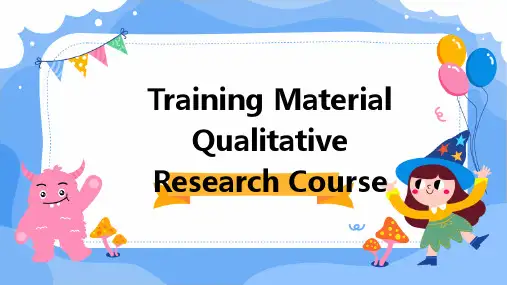
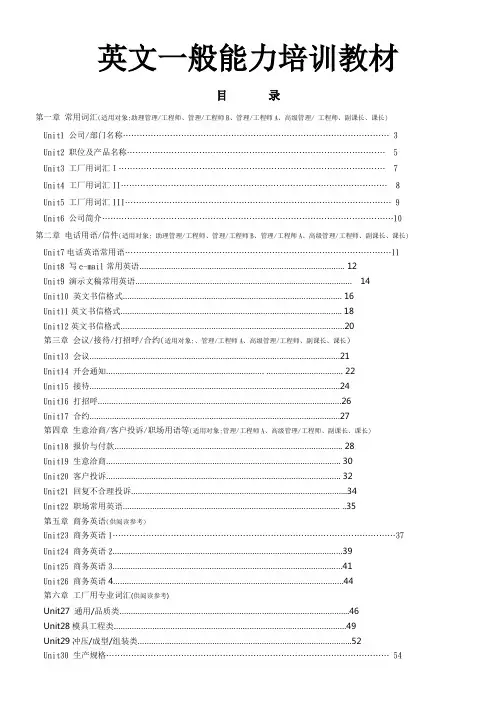
英文一般能力培训教材目录第一章常用词汇(适用对象:助理管理/工程师、管理/工程师B、管理/工程师A、高级管理/ 工程师、副课长、课长) Unit1 公司/部门名称 (3)Unit2 职位及产品名称 (5)Unit3 工厂用词汇I (7)Unit4 工厂用词汇II (8)Unit5 工厂用词汇III (9)Unit6 公司简介 (10)第二章电话用语/信件(适用对象: 助理管理/工程师、管理/工程师B、管理/工程师A、高级管理/工程师、副课长、课长) Unit7电话英语常用语 (11)Unit8写e-mail常用英语 (12)Unit9 演示文稿常用英语 (14)Unit10 英文书信格式 (16)Unit11英文书信格式 (18)Unit12英文书信格式 (20)第三章会议/接待/打招呼/合约(适用对象:、管理/工程师A、高级管理/工程师、副课长、课长)Unit13 会议 (21)Unit14 开会通知...................................................................... . (22)Unit15 接待 (24)Unit16 打招呼 (26)Unit17 合约 (27)第四章生意洽商/客户投诉/职场用语等(适用对象:管理/工程师A、高级管理/工程师、副课长、课长)Unit18 报价与付款 (28)Unit19 生意洽商 (30)Unit20 客户投诉 (32)Unit21 回复不合理投诉 (34)Unit22 职场常用英语…………………………………………………………………………………… ..35第五章商务英语(供阅读参考)Unit23 商务英语1 (37)Unit24 商务英语2 (39)Unit25 商务英语3 (41)Unit26商务英语4 (44)第六章工厂用专业词汇(供阅读参考)Unit27 通用/品质类 (46)Unit28模具工程类 (49)Unit29冲压/成型/组装类 (52)Unit30 生产规格 (54)第一章常用词汇Unit 1 公司/部门名称1 company公司1.1 Kinpo Electronics (China) Co., LTD金宝电子(中国)有限公司2.Plant & Div.& Dept.& Section 厂&处&部&课2.1 Plant director office厂长室2.2 Operation Div. 事业处2.3 R&D Div.设计处2.4 department 部门3. MFG: manufacturing 制造3.1 AI: auto insertion自动插件3.2 SMT自动粘着3.3Assembly组装3.4 preforming 加工4. Material 物料4.1 purchasing采购4.2 PC Center 生管中心4.3 W.H.: warehouse 仓库4.5 Local Procurement陆购4.6 Tools management模具管理4.7 Source Development料源开发5.QA品保5.1VQA 进料品质保证5.2 QA Engineering品保工程5.3 QA System 品保系统5.4 PQC ,FQC 制程品管5.5 Calibration , safety仪校,安规6.PE: production engineering制造工程6.1 ME mechanical engineering 制工(机械工程)6.2 IE: industrial engineering 工业工程6.3 NPI 技发6.4 QT Dept.品技部7. Custom Business 关务8.Import & Export进出口9.HR: human resources人力资源9.1 Administration 人事行政10. Factory Affairs 厂务10.1 Factory Service工务10.2 Miscellany Procurement总务采购11.R&D: Research & Design 设计11.1 Electric电子11.2 Artworks美工11.3 ME/ Tools模具11.4 Mechanic机械11.5 Software软件12. Accounting会计13.Financial财务14.Document Center (database center)资料中心15. responsible department负责单位16. production unit生产单位17. distribution department分发单位Unit 2职位/产品名称一.职位名称1.position 职务2.Chairman of the Board 董事长3.President (Am E.), Managing Director(MD)总裁4.Executive Vice-President 执行副总裁5.Managing Director 行政董事6.Executive Manager, General Manager 总经理7.Deputy General Manager 副总经理8.special assistant 特助9.Section Manager 部门经理,科长10.deputy manager=vice manager副理11.supervisor课长12.deputy supervisor , vice supervisor 副课长13.deputy manager=vice manager=Assistant Manager 助理经理 (副经理)14.Manager 主任15.Supervisor 主管16.executive 高中级管理人员17.clerk 职员18.group leader 组长19.assistant 助理20.Personnel Manager 人事经理21.secretary秘书22.operator作业员23.engineer工程师24.inspector检验员二.产品名称puter计算机类产品1.1 mouse鼠标1.2 printer打印机1.3 digit camera数码相机1.4 personal digit assistant个人数字助理器2.Consumer electronics消费性电子产品2.1 calculator电子计算器2.2 electronic address book电子辞典2.3 Organizer电子记事本2.4 Electronic Dictionary电子辞典munication通讯类产品3.1 cell phone 微型电话3.2 GPS Global Positioning System卫星定位器3.3 ADSL(Asymmetrical Digital Subscriber Line)非对称数字用户环路Unit 3 工厂用词汇I一.color颜色1.black 黑色2.blue 蓝色3.brown 棕色4.gold金色5.gray灰色6.green绿色7.orange橙色8.red红色9.silver银色10.violet(purple)紫色 11.white白色 12.yellow黄色二.Ver 动词1.change改变2.pay付给3.check检查4.produce产生e来6.provide提供7.damage损伤8.receive收到9.find发现10.replace代替 11.fix修理 12.send发出13.go去 14.take采取,拿 15.happen发生16.touch碰触 17.improve改善 18.wind缠绕19.insert插入 20.issue发行 21.make做,使三.Non 名词1.action 动作2.analysis分析3.condition条件4.data资料5.defect 缺点6.disposition处置7.engineer工程师 8.failure失败9.file 活页夹 cation and Training教育训练11.classification(sorting, organization)整理 12.regulation(arrangement, tidiness)整顿13.cleanliness(sweeping, purity)清扫 14.conservation(cleaning, cleanliness)清洁15.culture(discipline)教养 16.save节约17.safety安全四.其它常用词1.model机种2.revision版本3.issued date发行日期4.P/N品名,料号5.remark备注6.reported by草拟7.checked by 审核 8.approved by核准9.proposal improvement/creative suggestion提案改善10.4MTH:Man,material,money,method,time,how 人力,物力,财务,技术,时间(资源)11.6M:man,machine,material,method,measurement,message 人,机,料,法,环,(信息)12.FN(factory notice):工厂变更通知13.ECN(engineering change notice)工程变更通知14.Immediated change 立即变更15. Running change 旧料用完用新料16.old rev.(旧版本)new rev.(新版本)17.drawing no /customer/ alteration ref (图号 / 客户 / 变更依据)Unit4 工厂用词汇II一.Component零件1.bobbin线轴2.shield背板3.bridge diode桥式整流4.triode三极管5.cable tie束带6.tape 胶布7.capactitor(Cap)电容 8.screw tapping自攻螺丝 9.case外壳10.screw machine机械螺丝 11.ceramic capacitor陶瓷电容 12.terminal端子13.chip capacitor芯片电容 14.transformer(X'FMR)变压器 15.chip resistor芯片电阻16.transistor晶体管 17.choke线圈 18.tube套管19.connector连接器 20.varistor突波吸收器 21.control board基板22.VR(variable resistance)可变电阻 23.diode二极管 24.washer 垫片25.epoxy树脂 26.zener齐纳 27.fan风扇28.photo couple光藕合二极管 29.FET场效晶体管 30.regulator稳压器31.filter滤波器 32.resistor电阻 33.fuse保险丝34.ricer铆钉 35.fuse clip保险丝底座 36.screw螺丝37.fuse holder保险丝底座 38.socket插座 39.glue胶40.solder bar锡棒 41.heatsink散热片 42.spring washer弹簧垫片43.IC集成电路 44.stand-off支柱 45.inductor电感46.star washer星形垫片 47.insulator绝缘片 48.switch开关49.jumper wire跳线 50.output cable输出线 bel标签52.output wire输出线 53.lock washer接地唾形垫片 54.PCB电路板55.NTC热敏电阻 56.LED发光二极管nut螺丝帽 57.tubber foot脚垫58.TEFLON铁弗龙套管二.Process制程1.assembly组立2.method方法3.burn-in(B/I) 崩应4.noise噪音5.flux助焊剂6.pallet栈板7.function test功能测试 8.paper纸张 9.gravity 比重10.Hi-pot test耐高压测试 11.insertion插件 12.problem 问题13.ORT可靠度测试 14.procedure程序 15.packing包装16.product产品 17.solder machine锡炉 18.production生产19.station站别 20.record记录 21.supplier/vendor厂商22.remark备注 23.temperature 温度 24.report 报告25.humidity湿度 26.requirement 要求 27.torque 扭距28.sample样品 29.touch-up(T/U)补焊(二次作业)30.target 目标yout设计图 32.trace(基板)线路 33.location位置34.waybill运货单Unit5 工厂用词汇III(品技类)1.ACCEPT允收2.KNOB开关钮3.REJECT 拒绝,4.MYLAR DOME圆形Mylar5.QUALITY品质6.BATTERY COVER,电池盖7.LOW CABINET,下壳, 8.BUZZER 蜂鸣器 9.UPPER CABINET上壳, 10.TOUCH接触 11.WIRE皮线 12.CARBON 碳墨13.RIGHT正确 14.SPRING 弹簧 15.LEFT 左16.KEY字键 17.LCD FIXER LCD固定架 BEL贴纸19.COVER盖子 20.BLISTER CARD泡壳 21.PLATE弹片22.INST BOOK说明书 23.SPONGE泡棉 24.DISPLAY WINDOW 显示窗25.SOLAR CELL太阳能电池 26.RUBBER FOOT橡胶脚垫 27.SWITCH COVER开关钮28.PAPER PAD纸垫 29.SPEED速度 30.FREPUERTY频率31.DOT圆点 32.BROKEN破 33.GAP间隙34.STEP步骤 35.FUNCTION功能 36.KEY字键37.SMALL小的、轻微的, 38.CHANGE变更 39.DATE日期40.RUNNING运行 41.BIG大的、重要的 42.SCREW螺丝43.SCRATCH刮伤 44.PC SHEET面板 45.SPEC规格46.HARD CASE护壳 47.PUSH推行/推动 48.SHAFT轴49.CHECK查核 50.PAPER HOLDER纸架 51.BAG外箱或包装箱52.GIFT BOOK说明书 PUTER计算机 54.INNER CARTON中箱55.RESET重新激活键 56.CHIP CAP贴片电容 57.LOGO BAR标志58.WARRANTY保证书 59.MEMORY记忆 60.RITING LABEL贴纸样版61.CLEAR清除 62.MARK标志、标记 63.PRESSURE压力64.WRIT文件 65.MACHINE机器 66.PRESS BUTTON按钮67. hot pressor温度控制箱 68.CRACK破裂 69.sharp nose pliers尖嘴钳70.touch up (T/U)手焊 71.hardness tester硬度计 72.solder ball锡球73.bridging短路 74. missing component缺件 75.wrong component错件76.lead free无铅 77.through hole穿孔点 78.printer head打字头. plate (NP)铭板 80.chip on board (COB) 81.insufficient solder锡量不足82.diagonal cutting pliers斜口钳83.print circuit board (PCB)印刷电路板84.print circuit board assembly (PCBA)印刷电路板组装.Unit 6 公司简介1. History Introduction公司发展史简介•1995/05 Investigation of Setting up a plant in China 开始在中国大陆寻求厂址•1995/09 Contract Made with local government 与当地政府签订合同•1995/09 Start the construction 开始建厂•1996/01 Facilities Layout & Setting 规划并添置设备•1996/03 Start Mass Production 开始量产•1996/04 First Time Shipment 首次出货•1997/05 Qualified ISO 9002 Certification 获得ISO 9002 认证•1999/06 Investigation for new factory 寻求新厂址•2000/12 Finished Hard ware 完成硬件配置•2001/05 GPS Mass Production & Shipping GPS量产与出货•2001/06 DSC Mass Production Start DSC 开始量产•2001/07 First Time DSC Shipment DSC 首次出货•2001/11 Start setting up facilities for HP product 开始为HP产品的生产购置设备2. Space Resource占地面积Floor space - 133,554 M2 Living - 44,485 M2 Factory - 89,069 M2Land space - 169,996 M23.Major Customers主要客户•Photo Printer : Hewlett Packard / Casio•Digital Still Camera : Ricoh/ Casio•GPS :Magellan•ADSL :DQT/ Kinpo•PDA: Casio/ Canon/ HTW/ Texas Instruments •Calculator : Canon/ Casio/ Citizen/ Sharp/ TI/ HP pany’s Address公司地址Kinpo Electronics (China) Co., Ltd. 金宝电子(中国)有限公司Sha Tou area , Chang An Town, 长安镇沙头管理区Dong Guan City,东莞市Guang Dong Province,广东省China.中国5.Postal Number邮编:523866Tel:0769~5321555Fax:(0769)5328215第二章电话用语/信件Unit 7 电话英语1、请找Tom听电话→以下用法均可May I speak to (with) Tom? = I’d like to speak to Tom, please.2、请问您是哪位→以下用法均可Who’s speaking? = Who is this, please? = May I ask who’s calling?3、请再说一次→以下用法均可I beg your pardon?= Pardon me? =Would you repeat that, please.4、请问您找谁? →以下用法均可Who would you like to talk to? = With whom do you wish to speak?5、请稍候.→以下用法均可Would you hold the line, please? =Could you wait for just one moment, please?Hold on, please.=One moment, please.=Just a second, please6、解释不能接听电话的原因(1)、He is not in. = He is out. 他外出不在(2)、He is away from his desk. = He is not at his desk.他不在位子上。
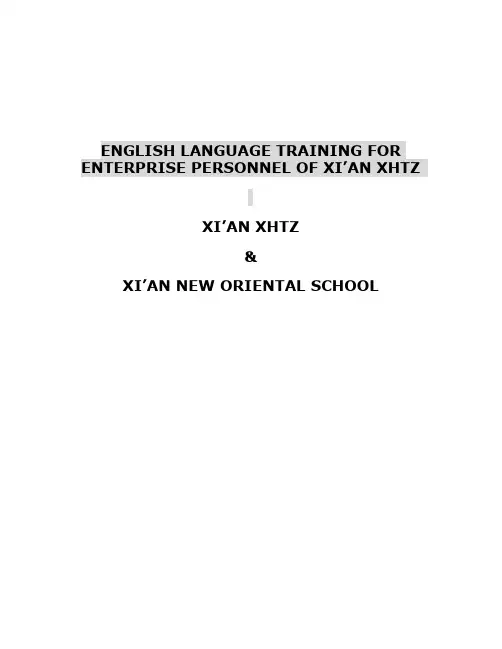
ENGLISH LANGUAGE TRAINING FOR ENTERPRISE PERSONNEL OF XI’AN XHTZXI’AN XHTZ&XI’AN NEW ORIENTAL SCHOOL目录Section One Pronunciation And Intonation_________________ 4 Section Two Business Talks_____________________________ 9 办公室常用英语___________________________________________ 9 常用的职务名称----------------------Common Titles ____ 10 工作任务流程(中英对照)__________________________________ 11 工作任务分配状况和报告相关的英语术语____________________ 13 part one_________________________________________________ 13 part two_________________________________________________ 14 商务外出英语100句______________________________________ 15 一般单位部门介绍________________________________________ 20 Introduction Of Xi’an XHTZ_____________________________ 20 Dialogue 1______________________________________________ 20 Dialogue 2______________________________________________ 20 Section three Everyday Communication__________________ 20 Unit 1 Meeting Foreign Guests at the Airport ____________ 20 Part I. Sample Dialogue________________________________ 20 Part II. Useful Sentences_____________________________ 20 Part III. Related Expressions_________________________ 20Unit 2 on the Way to the Hotel__________________________ 20 Part I. Sample Dialogue_________________________________ 20 Part II. Useful Sentences______________________________ 20 Part III. Related Expressions_________________________ 20 Unit 3 Making Phone Calls_______________________________ 20 Part I. Sample Dialogue_________________________________ 20 Part II. Useful Sentences______________________________ 20 Part III. Related Expressions__________________________ 20 Unit 4 At a Restaurant__________________________________ 20 Part I. Sample Dialogue_________________________________ 20 Part II Useful Sentences________________________________ 20 Part III. Related Expressions__________________________ 20 Unit 5 Visiting a Factory_______________________________ 20 Part I. Sample Dialogue_________________________________ 20 Part II. Useful Sentences______________________________ 20 Part III. Related Expressions_________________________ 20 Unit 6 Company Introduction____________________________ 20 Part I. Sample Dialogue_______________________________ 20 Part I I. Useful Sentences____________________________ 20 Part III. Related Expressions_________________________ 20Unit 7 City Introduction and Sightseeing________________ 20 Part I. Sample Dialogue_______________________________ 20 Part II. Useful Sentences_____________________________ 20 Part III. Related Expressions_________________________ 20 Unit 8 Talking about Weather___________________________ 20 Part I. Sample Dialogue________________________________ 20 Part II. Useful Sentences:_____________________________ 20 Part III. Related Expressions_________________________ 20 Unit 9 Parting_________________________________________ 20 Part I. Sample Dialogue________________________________ 20 Part II. Useful Sentences_____________________________ 20 Part III. Related Expressions_________________________ 20 Unit 10 Welcome Speech_________________________________ 20 Part I. Sample Speech__________________________________ 20 Part II. Useful Sentences_____________________________ 20 Part III. Related Expressions_________________________ 20 Introduction Of Xi’an__________________________________ 20 A brief introduction to Xi’an__________________________ 20 Cultural and Historical Sites in Xi’an_________________ 20 Tr aditional Arts & Handicrafts in Xi’an________________ 20Local Snacks & Refreshments in Xi’an___________________ 20Section One Pronunciation And Intonation语音语调强化It is common to many people that often times you have been learning how to read and write but have not had much practice in conversations. Here are what I see as the main difficulties:1. The speed that people speak at is faster than someone learning English can keep up, and people often don't annunciate: they slur words together a lot.2. Someone learning English as a second language usually needs to translate a sentence in order to understand (English to Chinese), and when responding, needs to translate a thought into the second language before saying it (Chinese to English).3. When speaking, you want to say something perfectly.The combination of the above makes it very hard to carry on a "normal" conversation.Here is my advice:1. If you want to improve, you must be willing to spend time in practicing it.2. You need to first build up a foundation, and this foundation is to be able to understand simple children's accent without hesitating.The final goal of the above is that you will have native accent, as well as thinking in English.Do you think it is possible? I can tell you that it is! If you are living in an environment where everybody speaks English, it will take 6 months. If you don't have that environment, it will take longer, but it is still possible.So my first question for you is:How much time are you willing to spend everyday in improving your English?四大读音要领牢记在心一、单词间的连读:当前面的单词以辅音结尾,紧随其后的单词以元音开头,这时将前面的辅音同后面的元音连在一起,像是构成一个音节一样地读出来,以使语言更具有流畅自然的特点。
英语听力训练材料English Listening Training Materials。
In today's globalized world, English has become an essential skill for communication, business, and academic success. One of the key components of English proficiency is the ability to understand and comprehend spoken English. Therefore, it is crucial for English learners to engage in regular listening practice to improve their listening skills. In this document, we will provide a variety of English listening training materials that can help learners enhance their listening abilities.1. Audio Recordings。
One of the most effective ways to improve English listening skills is through regular exposure to authentic audio recordings. This can include listening to English news broadcasts, podcasts, interviews, and speeches. By regularly listening to a wide range of audio materials, learners can become more familiar with different accents, speech patterns, and vocabulary usage in English.2. Listening Comprehension Exercises。
AOAC_2007英文版_01内部培训资料AOAC_2007英文版_01 Internal Training MaterialIntroduction:In this training material, we will discuss the AOAC (Association of Official Analytical Chemists) 2007 English version and its significance in quality assurance and food safety. This guide aims to provide a comprehensive understanding of the AOAC methods and their importance in laboratory testing and analysis.1. Background of AOAC:The Association of Official Analytical Chemists (AOAC) is a globally recognized organization that develops and validates analytical methods for various industries, including food, pharmaceuticals, agriculture, and environmental analysis. Founded in 1884, AOAC ensures the reliability and accuracy of analytical data through rigorous scientific standards.2. Purpose of AOAC Methods:The AOAC methods serve multiple purposes in the field of analytical chemistry. They provide standardized procedures for testing and analysis, ensuring consistency and comparability of results across different laboratories. By establishing a common ground for measurement, the AOAC methods enable accurate determination of various parameters, such as nutrient content, contaminants, and adulterants in food and other matrices.3. Benefits of AOAC Methods:The utilization of AOAC methods offers several advantages in laboratory testing and analysis:a) Reliability: AOAC methods are thoroughly validated and have undergone extensive peer review, ensuring their reliability in generating accurate and precise results.b) Consistency: The standardized procedures outlined in AOAC methods allow for consistent sample preparation, instrument calibration, and data interpretation, reducing variability between different laboratories and analysts.c) Traceability: AOAC methods provide a clear documentation trail, including detailed instructions, calculations, and quality control measures. This traceability enhances transparency and facilitates result comparison and verification.d) Regulatory Compliance: Many regulatory bodies and organizations, including the US Food and Drug Administration (FDA) and the European Food Safety Authority (EFSA), recommend or require the use of AOAC methods for the analysis of food and other products. Adhering to these methods ensures compliance with regulatory standards.4. AOAC Performance Tested Methods:AOAC offers a program called "Performance Tested Methods" (PTM) to verify the accuracy and reliability of analytical methods developed by manufacturers and laboratories. The PTM certification assures users that a particular method has met the stringent criteria set by AOAC regardingmethod performance and ruggedness. PTM-certified methods provide an extra level of confidence in the accuracy of results.5. AOAC Official Methods of Analysis:AOAC Official Methods of Analysis (OMA) are widely recognized standards used by laboratories worldwide. These methods undergo extensive validation and review processes, involving collaborative studies across multiple laboratories to ensure their accuracy and reproducibility. OMA methods cover a wide range of parameters, including microbiological analysis, pesticide residue determination, proximate analysis, and mycotoxin detection.Conclusion:The AOAC 2007 English version plays a crucial role in ensuring the quality and safety of food and other products through standardized and validated analytical methods. By following these methods, laboratories can generate reliable and accurate results, contributing to consumer protection and regulatory compliance. The AOAC methods provide a foundation for consistent and traceable measurement practices, enabling effective quality assurance and reliable product testing in various industries.。
英文能力培训计划表IntroductionEnglish is one of the most widely spoken languages in the world, and having a good command of it can open up a world of opportunities. Whether it's for business, travel, or personal growth, improving your English skills can have a significant impact on your life. This training plan is designed to help individuals improve their English abilities, whether they are just starting out or looking to refine their existing skills. The plan will cover various aspects of English language learning, including speaking, listening, reading, and writing, and will incorporate a mix of structured lessons, practice exercises, and real-world applications.GoalsThe primary goal of this training plan is to help individuals develop a strong command of the English language, with the ability to communicate effectively in both formal and informal settings. This includes improving speaking and listening skills, reading comprehension, and writing ability.ObjectivesThe following objectives will guide the training plan:1. Improve speaking skills: Focus on pronunciation, vocabulary, and fluency, with the ability to engage in meaningful conversations in English.2. Enhance listening skills: Improve the ability to understand spoken English in various accent and speed.3. Develop reading comprehension: Strengthen the ability to comprehend and analyze written English material, including newspapers, articles, and books.4. Refine writing ability: Improve grammar, vocabulary, and sentence structure, with the ability to write clear and coherent English text for different purposes.Training PlanWeek 1-4: Speaking SkillsDuring the first four weeks of the training plan, the focus will be on improving speaking skills. Participants will engage in daily speaking exercises, including dialogues, role-plays, and discussions, to build fluency and confidence in speaking English. They will also work on pronunciation, stress, and intonation through targeted exercises and feedback. In addition, participants will be encouraged to engage in real-life English conversations, such as ordering food or asking for directions, to practice their speaking skills in a practical setting. Week 5-8: Listening SkillsThe next phase of the training plan will focus on enhancing listening skills. Participants will listen to a variety of English audio materials, including podcasts, interviews, and lectures, to improve their ability to understand spoken English. They will also practice note-taking and summarizing to help improve their listening comprehension. In addition, participants will engage in listening exercises that challenge them to understand English in different accents and speeds, to prepare them for real-world listening situations.Week 9-12: Reading ComprehensionDuring the third phase of the training plan, participants will work on developing their reading comprehension skills. They will read a variety of English materials, such as news articles, short stories, and essays, and engage in comprehension exercises to improve their ability to understand and analyze written English. Participants will also work on expanding their vocabulary and learning strategies for reading comprehension, such as skimming and scanning. In addition, they will be encouraged to engage in reading for pleasure to further develop their reading skills.Week 13-16: Writing AbilityThe final phase of the training plan will focus on refining participants' writing ability. They will work on grammar, sentence structure, and vocabulary through targeted writing exercises, such as essays, reports, and emails. Participants will also receive feedback on their writing and work on improving their overall writing coherence and clarity. In addition, they will be encouraged to engage in real-life writing activities, such as writing letters or emails, to practice their writing skills in a practical setting.AssessmentThroughout the training plan, participants will be assessed on their progress in speaking, listening, reading, and writing. Assessments will include oral presentations, listening comprehension tests, reading analysis exercises, and writing assignments. Participants' performance and improvement will be monitored, and feedback will be provided to help them further develop their English abilities.ConclusionThis training plan is designed to help individuals improve their English abilities through a structured and comprehensive approach. By focusing on speaking, listening, reading, and writing, participants will develop a strong command of the English language that will enable them to communicate effectively in various contexts. With the support of this training plan, individuals can build the confidence and skills necessary to excel in their personal and professional lives.。